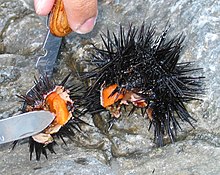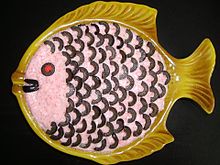Roe: Difference between revisions
| Line 10: | Line 10: | ||
==Around the world== |
==Around the world== |
||
===Asia=== |
===Asia=== |
||
| ⚫ | |||
| ⚫ | |||
====Bangladesh ==== |
====Bangladesh ==== |
||
Roe from the [[hilsa]] fish is considered a delicacy in [[Bangladesh]]. The roe is usually deep-fried, although other preparations such as '''mashed roe''' where the roe crushed along with oil, onion & pepper, or '''curry of roe''' can also be found. |
Roe from the [[hilsa]] fish is considered a delicacy in [[Bangladesh]]. The roe is usually deep-fried, although other preparations such as '''mashed roe''' where the roe crushed along with oil, onion & pepper, or '''curry of roe''' can also be found. |
||
| ⚫ | |||
| ⚫ | |||
====India ==== |
====India ==== |
||
Revision as of 10:58, 16 July 2011
This article needs additional citations for verification. (December 2008) |
Roe or hard roe is the fully ripe internal ovaries[citation needed] or egg masses of fish and certain marine animals, such as shrimp, scallop and sea urchins. As a seafood, roe is used both as a cooked ingredient in many dishes and as a raw ingredient.
The term soft roe or white roe denotes fish milt.

Around the world
Asia
Bangladesh
Roe from the hilsa fish is considered a delicacy in Bangladesh. The roe is usually deep-fried, although other preparations such as mashed roe where the roe crushed along with oil, onion & pepper, or curry of roe can also be found.
China
In many regions in China crab and urchin roes are eaten as a delicacy. They are used in small quantities to top Chinese steamed eggs.
India
In the state of Kerala, roe is deep fried in coconut oil, and is considered a delicacy. Among the tribal populace, roe that has been deeply-roasted over an open fire is a delicacy. In this region, the roe of rohu is also considered a delicacy and is eaten fried or as a stuffing within a fried pointed gourd to make potoler dolma.
All along the Konkan coast and Northern Kerala, the roe of sardines, black mackerel and several other fish is considered a delicacy. The roe can be eaten fried (after being coated with red chilli paste) and also as a thick curry (gashi). In Kerala, a common method of quick preparation is to wrap the roe in wet banana leaves and cook it over charcoal embers.
Iran
In the Caspian provinces of Gilan and Mazandaran, several types of roe are used. Called ashpal or ashbal, roe is consumed grilled, cured, salted, or mixed with other ingredients. If salted or cured, it is consumed as a condiment. If used fresh, it is usually grilled, steamed, or mixed with eggs and fried to form a custard-like dish called "Ashpal Kuku".
Besides the much sought-after caviar, roe from kutum (also known as Caspian white fish or Rutilus frisii kutum), roach (called "kuli" in Gileki), bream (called "kulmeh" in Gileki), and Caspian salmon are highly prized. Roe from carp is less common and barbel roe is also occasionally used.
Japan

A variety of roe types are used in Japanese cuisine, including the following which are used raw in sushi:
- Ikura (イクラ) - Salmon roe. Large reddish-orange individual spheres. Since salmon eggs are also used as bait, first-time sushi eaters who have experienced fishing may be taken aback when served ikura. It is a loan word from the Russian, "ikra" (caviar).
- Sujiko (すじこ) - Also salmon roe. The difference is that sujiko is still inside its sack when it is prepared. It also has a different color; sujiko is red to dark-red while ikura is lighter in color, sometimes almost orange. Sujiko is also sweeter in taste.
- Masago - Smelt roe, similar to Tobiko, but smaller.
- Kazunoko (数の子/鯑) - Herring roe, yellow or pinkish, having a firm, rubbery texture and appearance, usually pickled. The roe is in a single cohesive mass and so looks like a piece of fish.
- Mentaiko (明太子) - Alaska pollock roe, spiced with powdered red pepper and surrounded by a thin, elastic membrane. Mentaiko is usually pink to dark red.
- Tarako (たらこ) - Salted Alaska pollock roe, sometimes grilled.
- Tobiko (飛び子) - Flying fish roe, very crunchy, reddish orange in color.

- Uni (うに, 雲丹) - Sea urchin roe, soft and melting. Color ranges from orange to pale yellow. Humans consume the reproductive organs ("roe") either raw or briefly cooked. Sea urchin roe is a popular food in Korean cuisine, and it is called "uni" in Japanese sushi cuisine. It is also a traditional food in Chile, known as an "erizo de mar". Apart from domestic consumption, Chile and a number of other countries export the sea urchin to Japan in order to meet its demand throughout the country. Traditionally considered an aphrodisiac, sea urchin roe has been found to contain the cannabinoid anandamide.[1]
- Karasumi (カラスミ, 鱲子) - is a specialty of Nagasaki and along with salt-pickled sea urchin roe and Konowata one of the three chinmi of Japan. It is made by desalinating salt pickled mullet roe and sundrying it.
Korea
All kinds of fish roe are widely eaten in Korea including sea urchin, salmon, herring, flying fish, cod, among others. Myeongran jeot (명란젓) refers to the jeotgal (salted fermented seafood) made with pollock roe seasoned with chili pepper powders. It is commonly consumed as banchan, small dish accompanied with cooked rice or ingredient for altang (알탕), a kind of jjigae (Korean stew). Mentaiko in Japanese cuisine was derived from Myeongran jeot.
Lebanon
Sea urchin roe, or toutia توتية as it is known locally, is eaten directly from the sea urchin shell fresh using a small spoon. Some people add a twist of lemon juice to the roe and eat it in Lebanese flat bread.
Europe
All around the Mediterranean, botargo is an esteemed specialty made of the cured roe pouch of flathead mullet, tuna, or swordfish; it is called bottarga (Italian), poutargue or boutargue (French), botarga (Spanish), batarekh (Arabic) or avgotaraho (Greek αυγοτάραχο).
Denmark
Lumpfish (stenbider) roe is used extensively in Danish cuisine, on top of halved or sliced hard-boiled eggs, on top of mounds of shrimp, or in combination with other fish or seafood. Another commonly eaten roe is that from the cod (torsk).
Greece

Tarama is salted and cured cod roe used to make taramosalata, a Greek meze consisting of tarama mixed with lemon juice, bread crumbs, onions, and olive oil; it is eaten as a dip.
Avgotaraho (αυγοτάραχο) or botargo is the prepared roe of the flathead mullet.
Italy
Bottarga is primary the salted and dried roe pouch of the northern bluefin tuna; can be also prepared with the dried roe pouch of the flathead mullet, even if it is considered of low quality and less tasty. It is used minced for dressing pasta or in slice with olive oil and lemon (Fishermen style).
Norway
Norwegian caviar is most commonly made from cod, but caviar made from lumpsucker or capelin roe is also available.
In some areas it is also common to fry the roe from freshly-caught fish, to be eaten on bread or with potatoes and flatbread.
Finland
Common whitefish and especially vendace from the fresh water lakes in Finland are renowned for the excellent delicate taste of the roe. Roe is served as topping of toast or on top a blini with onion and smetana.
Portugal
Codfish roe and sardine roe are sold in olive oil. The fresh roe of hake (pescada) is also consumed (a popular way of eating it is boiled with vegetables, and simply seasoned with olive oil and a dash of vinegar). In the South of Portugal, the "ouriço do mar" (sea urchin) is highly appreciated. In the Sines area (Alentejo), a layer of dried pine needles is placed on the ground and, on top of it, a layer of sea urchins. This layer is topped with a second layer of dried pine needles. The pile is set on fire. The roe is removed from the cooked sea urchins and eaten. Sea urchin is not consumed in May, June, July, and August.
Romania
Fish roe is very popular in Romania as a starter or sometimes served for breakfast on toasted bread. The most common roe is that of the European carp; pike, herring, cod are also popular. Fried soft roe is also a popular dish. Sturgeon roe is a delicacy normally served at functions.

Russia
In Russian all types of fish roe are called "икра", and there's no language distinction between roe and caviar, although sturgeon roe, called "чёрная икра" ("black caviar") is most prized. It is usually lightly salted and eaten on a buttered rye bread, or used as an ingredient in various sauces and dishes of the haute cuisine. It's followed in prestige by the salmon roe, called "red caviar", which is less expensive but still considered a delicacy. More common roes, such as cod, pollock and herring are everyday dishes. Salted cod or pollock roe on a buttered bread is a common breakfast fare and herring roe is often eaten smoked or fried. Freshwater fishes' roes are also popular but their commercial availability is lower. Soft roe of various fishes is also widely consumed, mostly fried, and is a popular cantina-style dish.
Spain
Traditionally in the North and North West Basque Region, Cantabria, Asturias, and Galicia sea urchin roe, known as huevas de oricio, is part of both traditional and nouvelle cuisine dishes. In Andalucía and the Mediterranean coast roe has been preserved by drying and brining since antiquity. Nevertheless, currently roe is commonly consumed throughout the country raw, sautéed, grilled, fried, and marinated or pickled. The most popular varieties of roe are hake and tuna.
Sweden
Smoked and salted cod roe paste, commonly served as sandwich topping is popular in Sweden. The most famous brand is Kalles kaviar.
United Kingdom
Roe consumed within the UK is generally soft roe as opposed to hard roe. Though not popular, herring roe is sold within many British supermarkets. Battered cod roe can also be bought within many fish and chip shops. Various tinned roes are on sale in supermarkets e.g. soft cod roes, pressed cod roes and herring roes.
North and South America
In North America, several kinds of roe are produced: salmon from the Pacific coast, shad and herring species like the American shad and alewife, mullet, paddlefish, American bowfin, and some species of sturgeon. Shad, pike and other roe are sometimes pan-fried with bacon.
Peru
In Peru roe is served in many seafood restaurants deep fried with a side of fresh onion salad. It is called Huevera Frita. Cojinova (Seriolella violacea) yields the best roe for this dish. Despite the fact that many people like it, it is hardly considered a delicacy. Upscale restaurants are not expected to offer it, but street vendors and smaller restaurants will make their first daily sales of it before they run out. Cojinova itself (considered a medium quality fish) is caught for its fish meal, not for its roe, which is considered a chance product. Sea urchin roe is considered a delicacy and it is used (at costumer request) to add strength to ceviche.
New Zealand
The Maori people and other New Zealanders eat sea urchin roe, called "Kina".[2] Kina is sold in fishshops, supermarkets, and alongside the road. Most commercial Kina is imported from the Chatham Islands.
References
- ^ Bisogno; et al. (1997). "Occurrence and metabolism of anandamide and related acyl-ethanolamides in ovaries of the sea urchin Paracentrotus lividus". Biochim Biophys Acta. 1346 (3): 338–48. PMID 9150253.
{{cite journal}}: Cite has empty unknown parameter:|coauthors=(help); Explicit use of et al. in:|last=(help) - ^ [1]



